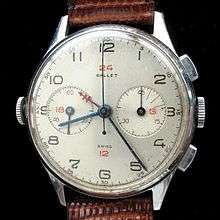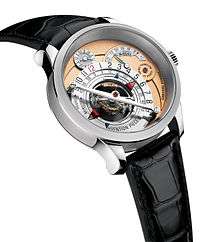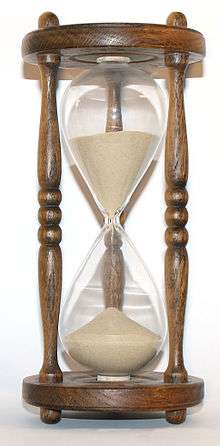Complication (horology)
In horology, a complication refers to any feature in a mechanical timepiece beyond the display of hours, minutes and seconds. A timepiece indicating only hours, minutes and seconds is known as a simple movement. Common complications include date or day-of-the-week indicators, alarms, chronographs (stopwatches), and automatic winding mechanisms. Complications may be found in any mechanical clock but are primarily a topic of note in mechanical watches where size constraints increase the difficulty of designing and assembly complications. A typical date-display chronograph may have up to 250 parts, while a particularly complex watch may have a thousand or more parts. Watches with several complications are referred to as grandes complications.
Types of complications

Timing complications (visible)
- Chronograph, with a second hand that can be stopped and started to function as a stopwatch.
- Double chronograph or rattrapante, multiple second hands for split-second, lap timing or timing multiple events
- Flyback chronograph, allowing rapid reset of the chronograph as it is running
- Counter chronograph
- Independent second-hand chronograph
- Jumping second-hand chronograph
- Simple calendar
- Quickset date
- Dead second (the second hand moves once per second instead of once per oscillation as in common mechanical movements)
- Foudroyante (or "flying seconds" - a dedicated hand that completes a full rotation in one second indicating fractions of a second)
- 24-hour watch (with an hour hand sweeping through 24 divisions rather than twelve)
Timing complications (hidden)
- Self-winding, using the motion of the wrist and arm to recapture energy
- Power reserve or réserve de marche
- Tourbillon, a mechanical refinement to an escapement that mitigates the effects of gravity on the operation of a timepiece
Astronomical complications
- Annual calendar
- Perpetual calendar
- Equation of time
- Time of sunset
- Time of sunrise
- Date of Easter
- Sign of the Zodiac
- Moon phases
- Mechanized star chart
- Astrolabe dial
- Planetarium dial
- Equation of time variation within the year
- Display of zone solar time (as opposed to standard time)
- Display of true local solar time
- Display of sidereal time
- Display of time zones
Striking complications
- Alarm
- Passing strike (chiming watch)
- Minute repeater
- Five-minute repeater
- Half-quarter repeater
- Quarter repeater
Nonhorological complications
By some definitions, a display on a watch may comprise a complications even if it is unrelated to timetelling. Some horologists discount nonhorological features (even those tangential to timekeeping such as winding mechanisms or power reserves) as being true complications. Examples include:
Grand complications

A grand complication is a watch with several complications, the most complex achievements of haute horlogerie, or fine watchmaking. Although there is no official definition,[1] one common criterion is that a watch contain at least one (visible) timing complication, one astronomical complication, and one striking complication.[2]
Ultra-complicated watches are produced in strictly limited numbers, with some built as unique instruments. Some watchmaking companies known for making ultra-complicated watches are Breguet, Patek Philippe, and Vacheron Constantin.[3] The initial ultra-complicated watches appeared due to watchmakers' ambitious attempts to unite a great number of functions in a case of a single timepiece. The mechanical clocks with a wide range of functions, including astronomical indications, suggested ideas to the developers of the first pocket watches. As a result, as early as in the 16th century, the horology world witnessed the appearance of numerous complicated and even ultra-complicated watches.
The most complicated pocket watch movements
As of November 2018, the top four most complicated mechanical watches ever created are manufactured by Vacheron Constantin and Patek Philippe, respectively.[4][5][6] In particular, the Patek Philippe Henry Graves Supercomplication currently holds the title of the most expensive watch ever sold at auction, with a final price of 24 million US dollars (23,237,000 CHF) sold in Geneva on November 11, 2014.[7][8][9][10] Two Patek Philippe Calibre 89 also currently rank among the top 10 most expensive watches ever sold at auction, with final prices over 5 million US dollars.[11][12][13][14]
- 1) The Vacheron Constantin Reference 57260 is now widely regarded as the most complicated watch in the world. It is a mechanical pocket watch which features 57 complications, introduced by Vacheron Constantin in 2015. The company claims that it is the most complicated mechanical pocket watch ever created. The Reference 57260 took eight years to assemble, and has 2826 parts and 31 hands. It weighs 957 grams, and spans 98mm.
- 2) The Patek Philippe Calibre 89 has 33 complications, using a total of 1728 parts. It was released in 1989 to commemorate the 150th anniversary of the company.[15] The complications include the date of Easter, sidereal time, and a 2800-star celestial chart.
- 3) The Supercomplication delivered to Henry Graves, Jr. in 1933 has 24 complications. The watch was reportedly the culmination of a watch arms race between Graves and James Ward Packard. The Super-complication took three years to design and five to build, and sports a chart of the nighttime sky at Graves' home in New York. It remains the most complicated watch (920 parts)[16] built without the assistance of computers.[17]
- 4) The Star Caliber 2000 has 21 complications. They include sunrise and sunset times and the lunar orbit, and it is capable of playing the melody of Westminster quarters (from Big Ben, the clock tower of the Houses of Parliament in London).
The most complicated wristwatch movement
The Franck Muller Aeternitas Mega 4 is the world's most complicated wristwatch. It has 36 complications, 25 of them visible, 1483 components and 1000-year calendar.[18]
The Hybris Mechanica Grande Sonnerie is the world's second most complicated wristwatch. Powered by the Jaeger LeCoultre Calibre 182 movement, with 27 complications and over 1300 parts. The movement is housed in a 44mm by 15mm 18k white gold case.[19]
References
- Perez, Carlos (June 10, 2001). "Of the Blood Royal". Carlos' Journal. TimeZone.com. Archived from the original on February 26, 2008. Retrieved 2008-04-20.
- Nicolet, J.C. (1999). "What does the term 'complication' mean, and how does it differ from 'grand complication'?". Questions in Time. Europa Star magazine online. Retrieved 2008-07-09.
- "Ultra-Complicated Watches - Unlimited Sophistication Watches Channel". watches.infoniac.com.
- "Vacheron Constantin reference 57260 - the most complicated watch". reference57260.vacheron-constantin.com. Retrieved 2018-11-30.
- "Hands-On: The Vacheron Constantin 57260, The Most Complicated Watch In The World (Exclusive Live Photos, Thoughts) - HODINKEE". HODINKEE. Retrieved 2018-11-30.
- "Hands-On: A Patek Philippe Caliber 89, For Sale At Christie's New York - HODINKEE". HODINKEE. Archived from the original on 2018-11-23. Retrieved 2018-11-30.
- Adams, Ariel. "$24,000,000 Patek Philippe Supercomplication Pocket Watch Beats Its Own Record At Auction". Forbes. Retrieved 2018-11-23.
- "Swiss Pocket Watch Sells for Record $24 Million". Time. Retrieved 2018-11-23.
- "Patek Philippe gold watch sells for record $24.4M - CNN". CNN Style. 2014-11-12. Retrieved 2018-11-23.
- "Patek Philippe (THE HENRY GRAVES JR. SUPERCOMPLICATION)". Sotheby's. Archived from the original on 2015-09-24.
- "The Yellow Gold Calibre 89 Patek Philippe". catalog.antiquorum.swiss. Archived from the original on 2018-11-24. Retrieved 2018-11-23.
- "Hands-On: A Patek Philippe Caliber 89, For Sale At Christie's New York - HODINKEE". HODINKEE. Archived from the original on 2018-11-23. Retrieved 2018-11-23.
- "Patek, Philippe, Genève. The white gold "Calibre 89"". catalog.antiquorum.swiss. Archived from the original on 2018-11-24. Retrieved 2018-11-23.
- "Patek Philippe Calibre 89 sold for $5 million". JCK. Archived from the original on 2018-11-23. Retrieved 2018-11-23.
- Watches - Switzerland - Information Archived 2012-03-05 at the Wayback Machine - swissworld.org, Federal Department of Foreign Affairs, General Secretariat, Presence Switzerland.
- Mulier, Thomas; Pulvirent, Stephen (November 12, 2014). "Most Expensive Watch: Patek Philippe Supercomplication Sets Record at $24 Million". Bloomberg.com. Retrieved November 12, 2014.
- "The story of the 'most complicated' watch in the world". BBC News. November 11, 2014.
- "World's Most Complicated Wristwatch: Franck Muller Aeternitas Mega 4". January 11, 2010.
- "Jaeger-LeCoultre: Hybris Mechanica à Grande Sonnerie". June 19, 2009.
External links
- Perez, Carlos (June 10, 2001). "Of the Blood Royal". Carlos' Journal. TimeZone.com. Archived from the original on February 26, 2008. Retrieved 2008-04-20.

